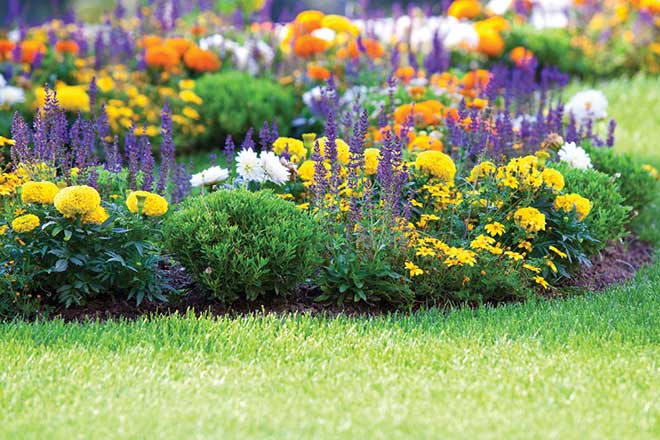Think of colorful blooms and vibrant evergreens as fashion accessories for your house. Just like there are trends for what to wear, so are there seasonal landscape trends, all dependent on our area’s hardiness zone and weather patterns. We spoke with two local landscape professionals to find out what kind of plants St. Louisans should ask for—and the best ways to show them off!
Kyla Scheuermann, landscape architect, Poynter Landscaping
> We’ve been planting a lot of Carpet roses, a really nice, hardy shrub for our area. It’s smaller than the typical rose bush, usually growing only about 3 feet tall. It will bloom all summer long and does well anywhere in the sun.
> The tall Green Giant arborvitae is more deer-resistant than any other arborvitae or evergreen tree, and it’s not as big as a spruce or hemlock. It’s more manicured than other evergreens and provides a great natural barrier for privacy.
> We also like to plant groun
> It’s best to plant complementary colors, and this spring, we’re using lots of purple and yellow together. Daffodils and purple crocuses look really good together, or a daylily with a tall purple bloom behind it, like an iris or cone flower, gives a good splash. Other colors that go well together are red and blue or red and yellow.
> A curved bed is easy to maintain and mow around, but it all depends on the architecture of the house; a more modern style might look better with a straight edge. We also look at the flow of traffic into the house, where the sidewalks are.
> If you want to save money and not mess with edging your flower beds, make a 2- to 3-inch cut in the soil along the edge. It will keep the mulch where it should be and prevent grass from growing into the bed (the roots are exposed to the air and won’t grow past the divot). It makes everything look really clean and crisp.
> Winter lingers in St. Louis. It’s still cold in March, and shrubs aren’t budding yet. To have color even during the winter, we recommend planting a large evergreen in the corner of your front yard or by a doorway. Scatter some boxwoods or azalea bushes to help as well.
> Plant trees at least 5 to 6 feet away from your house, depending on their size. It’s nice to plant a tree central to a window to provide a screen from the street.
Jim Graeler, owner, Chesterfield Valley Nursery
> Customers ask for deer-resistant plants that are low maintenance, and from there, we create something that’s unique and special within those realms. Avoid a cookie-cutter look by planting a mixture of Japanese maples and different varieties of conifers and boxwoods, like Vardar Valley and Justin Brouwers.
> Knockout roses have seen their time in the spotlight; people aren’t doing as much with those because they realize how big they get. We like using a smaller, dwarf variety called the Drift rose.
> We don’t follow any trend for colors; we look at the features of the house and choose flowers that complement the colors of the home’s materials. People tend to like softer colors; we’re currently using a lot of light pink and purple.
> The design of the landscape bed is dependent on the home’s architecture as well. Every job has different elements to it, but we always like to layer, tall to short, from the outside in. We start with something tall on either end to create height, frame the house and soften its corners.
> Always tie in colorful blooms with evergreens, something to give you a year-round look.
> If you choose the right ground cover, you can cut down on maintenance and create a well-kept look. Ivy requires more maintenance, but it can look beautiful in the right setting. It’s best used in the backyard as a ground cover in a flower bed where you want erosion control. I’m a big fan of pachysandra, an evergreen ground cover that likes the shade. It’s perfect under a canopy of trees, has a soft texture and doesn’t grow too tall. It gives great color year-round and is low maintenance.
> Mulch is the way to go for flower beds. It’s beneficial for the plants because it adds nutrient value and organic material to the soil.
